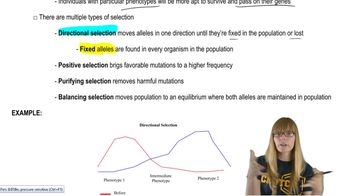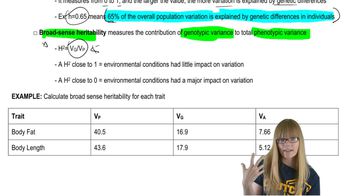Table of contents
- 1. Introduction to Genetics51m
- 2. Mendel's Laws of Inheritance3h 37m
- 3. Extensions to Mendelian Inheritance2h 41m
- 4. Genetic Mapping and Linkage2h 28m
- 5. Genetics of Bacteria and Viruses1h 21m
- 6. Chromosomal Variation1h 48m
- 7. DNA and Chromosome Structure56m
- 8. DNA Replication1h 10m
- 9. Mitosis and Meiosis1h 34m
- 10. Transcription1h 0m
- 11. Translation58m
- 12. Gene Regulation in Prokaryotes1h 19m
- 13. Gene Regulation in Eukaryotes44m
- 14. Genetic Control of Development44m
- 15. Genomes and Genomics1h 50m
- 16. Transposable Elements47m
- 17. Mutation, Repair, and Recombination1h 6m
- 18. Molecular Genetic Tools19m
- 19. Cancer Genetics29m
- 20. Quantitative Genetics1h 26m
- 21. Population Genetics50m
- 22. Evolutionary Genetics29m
1. Introduction to Genetics
History of Genetics
Problem 7
Textbook Question
Define natural selection, and describe how natural selection operates as a mechanism of evolutionary change.
 Verified step by step guidance
Verified step by step guidance1
Natural selection is a process where organisms better adapted to their environment tend to survive and produce more offspring.
The theory of natural selection was first formulated by Charles Darwin and is a key mechanism of evolution.
Natural selection operates through variation, where individuals in a population have different traits.
These variations can affect an individual's ability to survive and reproduce in a given environment.
Over time, advantageous traits become more common in the population, leading to evolutionary change.
Recommended similar problem, with video answer:
 Verified Solution
Verified SolutionThis video solution was recommended by our tutors as helpful for the problem above
Video duration:
1mPlay a video:
Was this helpful?
Key Concepts
Here are the essential concepts you must grasp in order to answer the question correctly.
Natural Selection
Natural selection is a fundamental mechanism of evolution, proposed by Charles Darwin. It describes the process by which individuals with advantageous traits are more likely to survive and reproduce, passing those traits to the next generation. Over time, this leads to the adaptation of species to their environments.
Recommended video:
Guided course

Natural Selection
Variation and Heritability
For natural selection to occur, there must be variation among individuals in a population, and these variations must be heritable. This means that traits can be passed from parents to offspring. Variations can arise from mutations, genetic recombination, and other processes, providing the raw material for natural selection to act upon.
Recommended video:
Guided course

Calculating Heritability
Survival of the Fittest
The phrase 'survival of the fittest' encapsulates the idea that individuals best suited to their environment are more likely to survive and reproduce. 'Fittest' refers not just to physical strength but to overall adaptability, including behaviors and reproductive success. This concept emphasizes the dynamic nature of populations as they respond to environmental pressures.
Recommended video:
Guided course

Natural Selection

 11:35m
11:35mWatch next
Master History of Genetics with a bite sized video explanation from Kylia Goodner
Start learningRelated Videos
Related Practice


